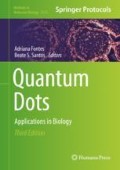Abstract
Colloidal quantum dots (QDs), due to their versatile optoelectronic properties, have been used in life science applications, especially in fluorescence-based techniques, for over two decades. A great variety of QD syntheses and conjugations are available, and tailoring these for the desired application requires a refined structural characterization. Life science applications rely on the interaction of QDs with biostructures; hence, the knowledge of the QD actual size (i.e., its hydrodynamic radius in the medium the experiment is being carried) and the size of their conjugates is paramount. Fluorescence correlation spectroscopy (FCS) is an optical technique that uses fluorophore light emission to measure its hydrodynamic radius, instead of relying on particle light scattering or crystalline structure, making it ideal for studying bioconjugated QDs in suspension. From the fluorescence intensity autocorrelation, FCS measures the diffusion coefficient of systems in a diluted sample and, by obtaining the diffusion coefficient, it is possible to calculate its hydrodynamic radius. In this chapter we describe the main aspects of the FCS technique and how to use it to calculate the hydrodynamic radius of QDs.
Access this chapter
Tax calculation will be finalised at checkout
Purchases are for personal use only
References
Alivisatos A (1996) Semiconductor clusters, nanocrystals, and quantum dots. Science 271(5251):933–937. https://doi.org/10.1126/science.271.5251.933
Bruchez M, Moronne M, Gin P, Weiss S, Alivisatos AP (1998) Semiconductor nanocrystals as fluorescent biological labels. Science 281(5385):2013–2016. https://doi.org/10.1126/science.281.5385.2013
Chan WCW, Nie SM (1998) Quantum dot bioconjugates for ultrasensitive nonisotopic detection. Science 281(5385):2016–2018. https://doi.org/10.1126/science.281.5385.2016
Pelaz B et al (2017) Diverse applications of nanomedicine. ACS Nano 11(3):2313–2381. https://doi.org/10.1021/acsnano.6b06040
Sheung JY, Ge PH, Lim SJ, Lee SH, Smith AM, Selvin PR (2018) Structural contributions to hydrodynamic diameter for quantum dots optimized for live-cell single-molecule tracking. J Phys Chem C 122(30):17406–17412. https://doi.org/10.1021/acs.jpcc.8b02516
Magde D, Webb WW, Elson E (1972) Thermodynamic fluctuations in a reacting system—measurement by fluorescence correlation spectroscopy. Phys Rev Lett 29(11):705. https://doi.org/10.1103/PhysRevLett.29.705
Amos WB, White JG (2003) How the confocal laser scanning microscope entered biological research. Biol Cell 95(6):335–342. https://doi.org/10.1016/s0248-4900(03)00078-9
Schwille P (2001) Fluorescence correlation spectroscopy and its potential for intracellular applications. Cell Biochem Biophys 34(3):383–408. https://doi.org/10.1385/cbb:34:3:383
Rigler R, Mets U (1993) Diffusion of single molecules through a Gaussian laser beam. 239–248. https://doi.org/10.1117/12.146154
Rigler R, Mets U, Widengren J, Kask P (1993) Fluorescence correlation spectroscopy with high count rate and low-background—analysis of translational diffusion. Eur Biophys J Biophys Lett 22(3):169–175
Krichevsky O, Bonnet G (2002) Fluorescence correlation spectroscopy: the technique and its applications. Rep Prog Phys 65(2):251–297. https://doi.org/10.1088/0034-4885/65/2/203
de Thomaz AA, Almeida DB, Pelegati VB, Carvalho HF, Cesar CL (2015) Measurement of the hydrodynamic radius of quantum dots by fluorescence correlation spectroscopy excluding blinking. J Phys Chem B 119(11):4294–4299. https://doi.org/10.1021/jp512214p
Doose S, Tsay JM, Pinaud F, Weiss S (2005) Comparison of photophysical and colloidal properties of biocompatible semiconductor nanocrystals using fluorescence correlation spectroscopy. Anal Chem 77(7):2235–2242. https://doi.org/10.1021/ac050035n
Heuff RF, Swift JL, Cramb DT (2007) Fluorescence correlation spectroscopy using quantum dots: advances, challenges and opportunities. Phys Chem Chem Phys 9(16):1870–1880
Author information
Authors and Affiliations
Corresponding author
Editor information
Editors and Affiliations
Rights and permissions
Copyright information
© 2020 Springer Science+Business Media, LLC, part of Springer Nature
About this protocol
Cite this protocol
Almeida, D.B., de Thomaz, A.A. (2020). Measuring the Hydrodynamic Radius of Colloidal Quantum Dots by Fluorescence Correlation Spectroscopy. In: Fontes, A., Santos, B. (eds) Quantum Dots. Methods in Molecular Biology, vol 2135. Humana, New York, NY. https://doi.org/10.1007/978-1-0716-0463-2_4
Download citation
DOI: https://doi.org/10.1007/978-1-0716-0463-2_4
Published:
Publisher Name: Humana, New York, NY
Print ISBN: 978-1-0716-0462-5
Online ISBN: 978-1-0716-0463-2
eBook Packages: Springer Protocols

